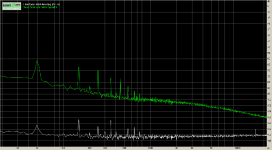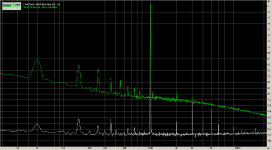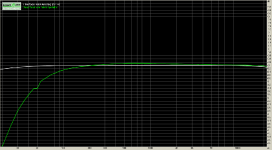Hi,
If you have a 60dB MC preamp on the bench, inputs shorted with blanking plugs, how much noise would you expect to see on the 'scope?
Up until recently I've been a devout user of transformers for MC-MM step-up, so I'm not too sure as to what constitutes a good figure. I've seen plenty of MM stages that have self-noise many dB below that of the cartridge itself, but have you ever seen this on an active MC stage?
OTOH, I'm thinking that below 500uV P-P of noise is acceptable for a consumer preamp (Inputs shorted). Below 250uV is good. Less than 100uV is exceptionally good. Would this tally with your opinion / experience?
Bear in mind I'm talking purely about looking at the noise trace on a 'scope, measuring the peak-to-peak level, not RMS. The RMS level would be a lot less - I'm judging it from how many divisions the general fuzz occupies on the screen.
Comments?
Thanks in advance.
Justin
edit - just to clarify, I'm talking solely about active MC stages here, not transformers.
If you have a 60dB MC preamp on the bench, inputs shorted with blanking plugs, how much noise would you expect to see on the 'scope?
Up until recently I've been a devout user of transformers for MC-MM step-up, so I'm not too sure as to what constitutes a good figure. I've seen plenty of MM stages that have self-noise many dB below that of the cartridge itself, but have you ever seen this on an active MC stage?
OTOH, I'm thinking that below 500uV P-P of noise is acceptable for a consumer preamp (Inputs shorted). Below 250uV is good. Less than 100uV is exceptionally good. Would this tally with your opinion / experience?
Bear in mind I'm talking purely about looking at the noise trace on a 'scope, measuring the peak-to-peak level, not RMS. The RMS level would be a lot less - I'm judging it from how many divisions the general fuzz occupies on the screen.
Comments?
Thanks in advance.
Justin
edit - just to clarify, I'm talking solely about active MC stages here, not transformers.
thermionic said:Hi,
If you have a 60dB MC preamp on the bench, inputs shorted with blanking plugs, how much noise would you expect to see on the 'scope?
Up until recently I've been a devout user of transformers for MC-MM step-up, so I'm not too sure as to what constitutes a good figure. I've seen plenty of MM stages that have self-noise many dB below that of the cartridge itself, but have you ever seen this on an active MC stage?
OTOH, I'm thinking that below 500uV P-P of noise is acceptable for a consumer preamp (Inputs shorted). Below 250uV is good. Less than 100uV is exceptionally good. Would this tally with your opinion / experience?
Bear in mind I'm talking purely about looking at the noise trace on a 'scope, measuring the peak-to-peak level, not RMS. The RMS level would be a lot less - I'm judging it from how many divisions the general fuzz occupies on the screen.
Comments?
Thanks in advance.
Justin
edit - just to clarify, I'm talking solely about active MC stages here, not transformers.
I don't consider myself an expert on MC preamps, but here is my opinion. Others may disagree, but this may help get you in the ballpark.
A good MC preamp should have an input-referred noise level of less than 1 nV/rt Hz in the mid audio band (it may rise a bit at lower frequencies).
In a 20 kHz bandwidth, there are 141 rt Hz, so the input-referred noise in that bandwidth should be 141 nV rms. After 60 dB of MC preamp gain, that will become 141 uV rms.
Here's the catch. Measuring peak-to-peak on an oscilloscope of probably much wider bandwidth will likely give you misleading results. You really want to measure rms noise in a bandlimited fashion, limited to 20 kHz.
As a very rough approximation, filter the output of the MC preamp with a single-pole lowpass at 20 kHz and measure the result on an average-responding ac millivolt meter. If you see less than 141 uV you are probably in the OK ballpark.
Cheers,
Bob
It is MUCH easier just to put a fixed resistance in series with the input. If you use an RCA jack input, then put a 50 ohm resistor (for example) across a phono plug and plug it in. Compare it to a phono plug that is shorted. You can adjust the resistor until you get a 3 dB increase in noise. If you want, and can do it easily, just roll off the bass with a high pass filter, just to make the measurement easier. This works fast and consistently.
john curl said:It is MUCH easier just to put a fixed resistance in series with the input. If you use an RCA jack input, then put a 50 ohm resistor (for example) across a phono plug and plug it in. Compare it to a phono plug that is shorted. You can adjust the resistor until you get a 3 dB increase in noise. If you want, and can do it easily, just roll off the bass with a high pass filter, just to make the measurement easier. This works fast and consistently.
This is a neat trick. Keep in mind that the thermal noise of a 50-ohm resistor is close to 1 nV/rt Hz, and that resistor noise increases as the square root of resistance. For example, a 100-ohm resistor would have a thermal noise of about 1.4 nV/rt Hz.
Also bear in mind that the resistor trick can introduce some error if the MC preamp has substantial input current noise, since many MC cartidges have a source impedance of less than 10 ohms, quite a bit less than the 50-ohm number. Fortunately, even at the 50-ohm impedance level the input current noise of a reasonably designed MC preamp will usually not be a big factor.
Looking at noise on a broadband scope with an MC preamp that might be fairly broadband itself could lead to some misleading results due to any RF pickup. Hopefully this will be small with a good layout and the input shunted with a test resistor right at the preamp input.
Also bear in mind that the normal MC preamp will usually be followed by RIAA equalization, which will attenuate very high frequencies.
Cheers,
Bob
Many thanks to both of you for the advice - much appreciated.
I intend to take an FFT of the preamp's noise floor and post back here. Its noise floor is below that of my digital 'scope, and just above that of my analogue 'scope. To measure it with a 'scope, I will need something like a Tek 7000 with the plug-in that goes down to a handful of uV. To take an FFT I will have to boost the Line o/p by a degree with a line buffer, but I doubt that will add enough noise to obscure the predominant noise signature of the preamp.
Upon auditioning, there's almost no hum (even quieter in this regard than using step-up transformers), but there is a 'wind' noise, akin to pink noise, which strikes me as noise that's filtered from the 2nd amp stage - i.e. where the RIAA filter is.
Has anyone ever made an active MC preamp, with 60dB + of gain, with a noise floor that's below the cart's self noise? (I've seen many MM preamps that are as such - even ones with old non-epitaxial transistors)
The resistor trick outlined by John is very nifty. Thanks again!
Justin
I intend to take an FFT of the preamp's noise floor and post back here. Its noise floor is below that of my digital 'scope, and just above that of my analogue 'scope. To measure it with a 'scope, I will need something like a Tek 7000 with the plug-in that goes down to a handful of uV. To take an FFT I will have to boost the Line o/p by a degree with a line buffer, but I doubt that will add enough noise to obscure the predominant noise signature of the preamp.
Upon auditioning, there's almost no hum (even quieter in this regard than using step-up transformers), but there is a 'wind' noise, akin to pink noise, which strikes me as noise that's filtered from the 2nd amp stage - i.e. where the RIAA filter is.
Has anyone ever made an active MC preamp, with 60dB + of gain, with a noise floor that's below the cart's self noise? (I've seen many MM preamps that are as such - even ones with old non-epitaxial transistors)
The resistor trick outlined by John is very nifty. Thanks again!
Justin
thermionic said:
Has anyone ever made an active MC preamp, with 60dB + of gain, with a noise floor that's below the cart's self noise?
http://www.diyaudio.com/forums/showthread.php?postid=1678221#post1678221
0.45nV/rtHz, 64dB gain for MC. Dead silent with 0.2mV 10ohm MC cartridge.
John, that is indeed a cool trick! Elegant and dead simple.
A very important point. If you use a topology where the RIAA follows the first stage, the effective delta F will be more like 120-130Hz.
Also bear in mind that the normal MC preamp will usually be followed by RIAA equalization, which will attenuate very high frequencies.
A very important point. If you use a topology where the RIAA follows the first stage, the effective delta F will be more like 120-130Hz.
-output noise peak-to-peak (95 percentile) is about 6 times more than the rms value.
- Nelson DIY phono preamp is low noise.. in the 1nV/rtHz ball park...
- Even the simplictic Pacific JFET preamp comes colse to the 1nV/rtHz.. get yourself 4 2Sk170's, les then a hand full of resistors and caps, and you can build yourself a nice low noise 40dB phono preamp that works well with MC cartridges..
just my 2 cts,
grtzz, Thijs
- Nelson DIY phono preamp is low noise.. in the 1nV/rtHz ball park...
- Even the simplictic Pacific JFET preamp comes colse to the 1nV/rtHz.. get yourself 4 2Sk170's, les then a hand full of resistors and caps, and you can build yourself a nice low noise 40dB phono preamp that works well with MC cartridges..
just my 2 cts,
grtzz, Thijs
thermionic said:I will need something like a Tek 7000 with the plug-in that goes down to a handful of uV. To take an FFT I will have to boost the Line o/p by a degree with a line buffer, but I doubt that will add enough noise to obscure the predominant noise signature of the preamp.
Justin
That would be 7A22 plugin, has filtering too. Tom Lee has a nice trick for eyeballing true RMS off of a scope trace, but I can't find it on line right now.
Hi,
Please see test data below. I used an RME Fireface 400 in unbalanced mode (MC Pre is unbalanced). A Lipshitz reverse-RIAA filter was inserted on the output of the RME. Because the RME didn't like driving the preamp's 68R input Z, I took my feed from the MM output of the Lipshitz filter to minimise bass rolloff (it's still 1.5dB down at 50 Hz though, but hum is not my concern here).
Thanks again to all.
Justin
Please see test data below. I used an RME Fireface 400 in unbalanced mode (MC Pre is unbalanced). A Lipshitz reverse-RIAA filter was inserted on the output of the RME. Because the RME didn't like driving the preamp's 68R input Z, I took my feed from the MM output of the Lipshitz filter to minimise bass rolloff (it's still 1.5dB down at 50 Hz though, but hum is not my concern here).
Thanks again to all.
Justin
RME Test data Input to Output:
Frequency response (from 40 Hz to 15 kHz), dB: +0.01, -0.06
Noise level, dB (A): -106.0
Dynamic range, dB (A): 105.9
THD, %: 0.0019
IMD + Noise, %: 0.016
Stereo crosstalk, dB: -101.7
IMD at 10 kHz, %: 0.040
MC Preamp In Circuit:
Frequency response (from 40 Hz to 15 kHz), dB: +0.14, -1.77
Noise level, dB (A): -72.0
Dynamic range, dB (A): 71.9
THD, %: 0.0055
IMD + Noise, %: 0.138
Stereo crosstalk, dB: -65.8
IMD at 10 kHz, %: 0.049
Hi,
Does anyone think these results are remotely meaningful in terms of judging the performance of this preamp?
I can only conclude that the 68R input Z is responsible for LF rolloff as I get a very flat response if I bypass the MC booster stage that precedes the MM / RIAA stage.
Any comments gratefully received.
Justin
Does anyone think these results are remotely meaningful in terms of judging the performance of this preamp?
I can only conclude that the 68R input Z is responsible for LF rolloff as I get a very flat response if I bypass the MC booster stage that precedes the MM / RIAA stage.
Any comments gratefully received.
Justin
Tumbleweeds blowing...
72dB? Can anyone give a comment? Does the slope in the FFT caused by the RIAA on the 2nd stage suggest the dominant noise is from the 1st stage? (RIAA filter is on inverting f/back of 2nd op-amp).
The 1st stage has 25dB gain, as opposed to the 2nd's 35dB
If there's a control plot, showing the soundcard's self-noise, then isn't this a fairly objective measurement? I appreciate that the Reverse-RIAA filter has its own noise btw. It's in an alloy, grounded case.
???
I'm sorry to be a PITA here...but someone must have an opinion.
TIA.
Justin
72dB? Can anyone give a comment? Does the slope in the FFT caused by the RIAA on the 2nd stage suggest the dominant noise is from the 1st stage? (RIAA filter is on inverting f/back of 2nd op-amp).
The 1st stage has 25dB gain, as opposed to the 2nd's 35dB
If there's a control plot, showing the soundcard's self-noise, then isn't this a fairly objective measurement? I appreciate that the Reverse-RIAA filter has its own noise btw. It's in an alloy, grounded case.
???
I'm sorry to be a PITA here...but someone must have an opinion.
TIA.
Justin
Does the slope in the FFT caused by the RIAA on the 2nd stage suggest the dominant noise is from the 1st stage? (RIAA filter is on inverting f/back of 2nd op-amp).
I'd think so given the shape of the noise floor and your gain structure, but there's an easy way to find out. Measure the noise at the output of the first stage directly.
Thanks SY. Does it appear overtly noisy for an MC stage to your eyes?
I've tried measuring noise at the O/P of the first stage, and it's below anything I can measure on either of my 'scopes (Tek TDS 2014 100mHz digital / 20mHz Kenwood). The same goes for the RIAA stage. I only get discernable noise when I chain the two together, and this is still below the measurement trigger threshold of the Tek.
There are people I work with that have AP analysers and the like. However, I was hoping to use some initiative, and find a way of refining an idea with the tools that I have access to, so I don't have to keep running to them every time I need to know the noise floor of something. I'm genuinely grateful for John's tip btw - the only concern I have is whether the kit I have is sensitive enough to measure an accurate 3dB increase... I really need to pony up for a serious meter I guess...it's that or a s/hand AP.
Justin
I've tried measuring noise at the O/P of the first stage, and it's below anything I can measure on either of my 'scopes (Tek TDS 2014 100mHz digital / 20mHz Kenwood). The same goes for the RIAA stage. I only get discernable noise when I chain the two together, and this is still below the measurement trigger threshold of the Tek.
There are people I work with that have AP analysers and the like. However, I was hoping to use some initiative, and find a way of refining an idea with the tools that I have access to, so I don't have to keep running to them every time I need to know the noise floor of something. I'm genuinely grateful for John's tip btw - the only concern I have is whether the kit I have is sensitive enough to measure an accurate 3dB increase... I really need to pony up for a serious meter I guess...it's that or a s/hand AP.
Justin
- Status
- This old topic is closed. If you want to reopen this topic, contact a moderator using the "Report Post" button.
- Home
- Amplifiers
- Solid State
- Noise Figures for MC Preamp (Inputs Shorted)


